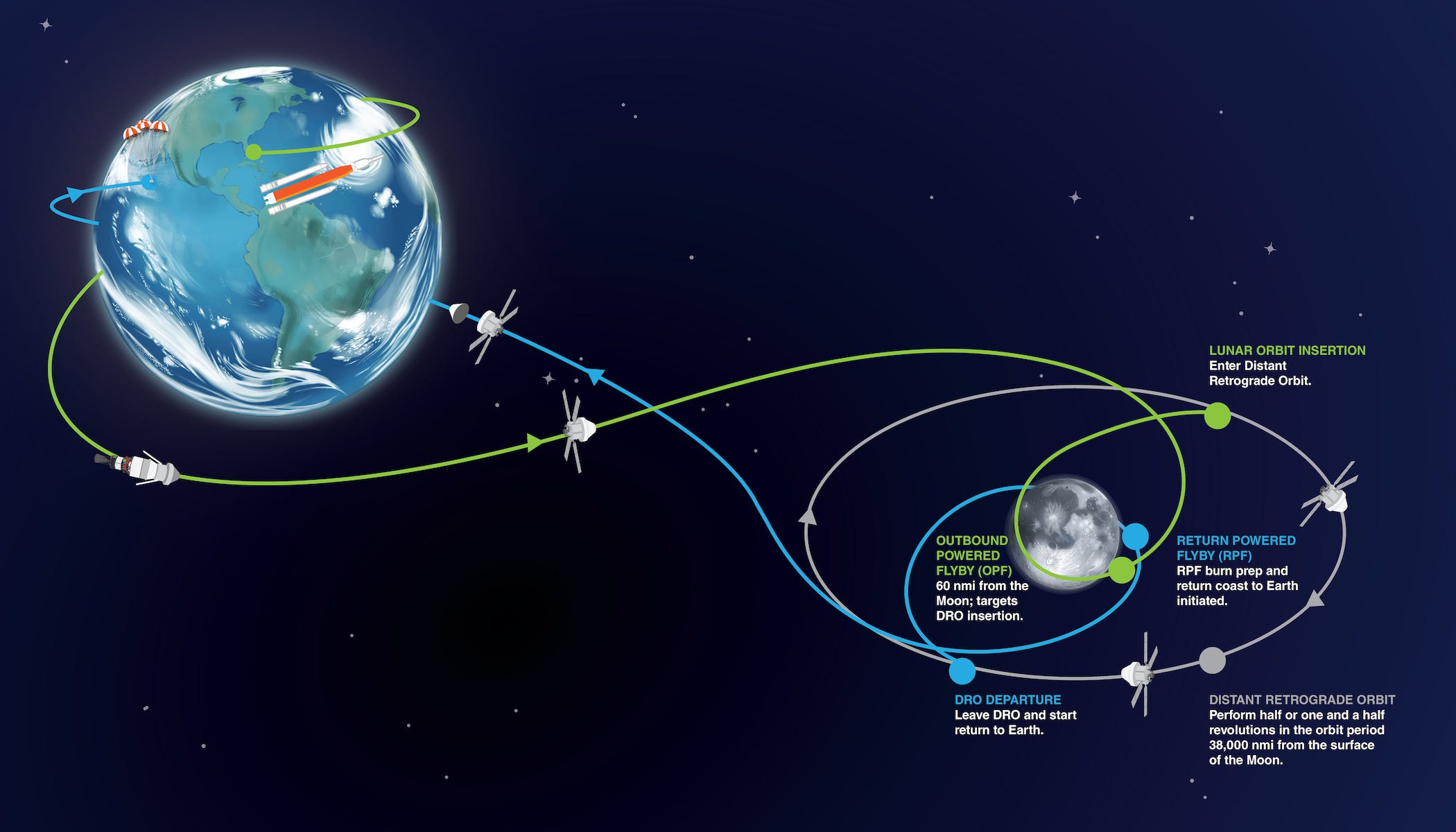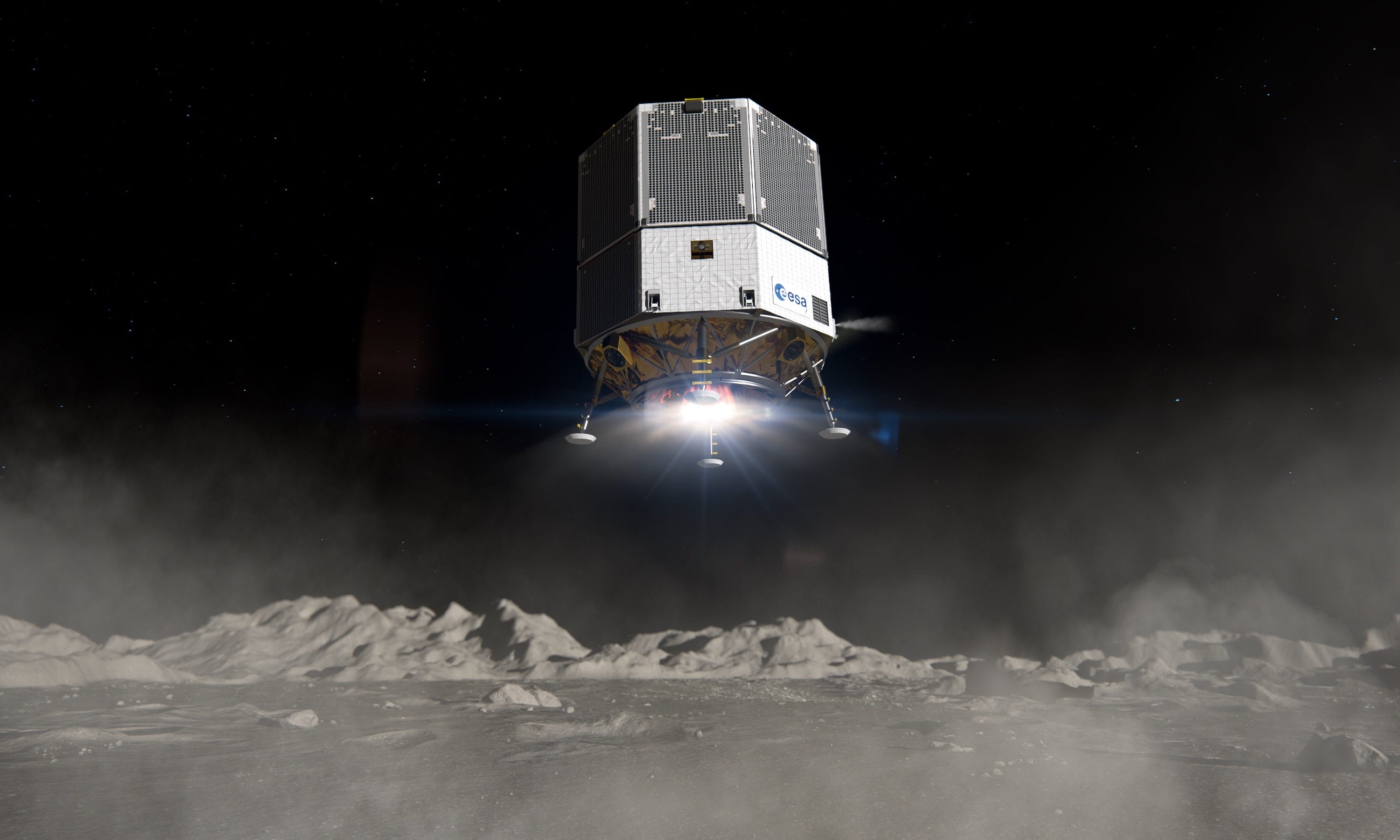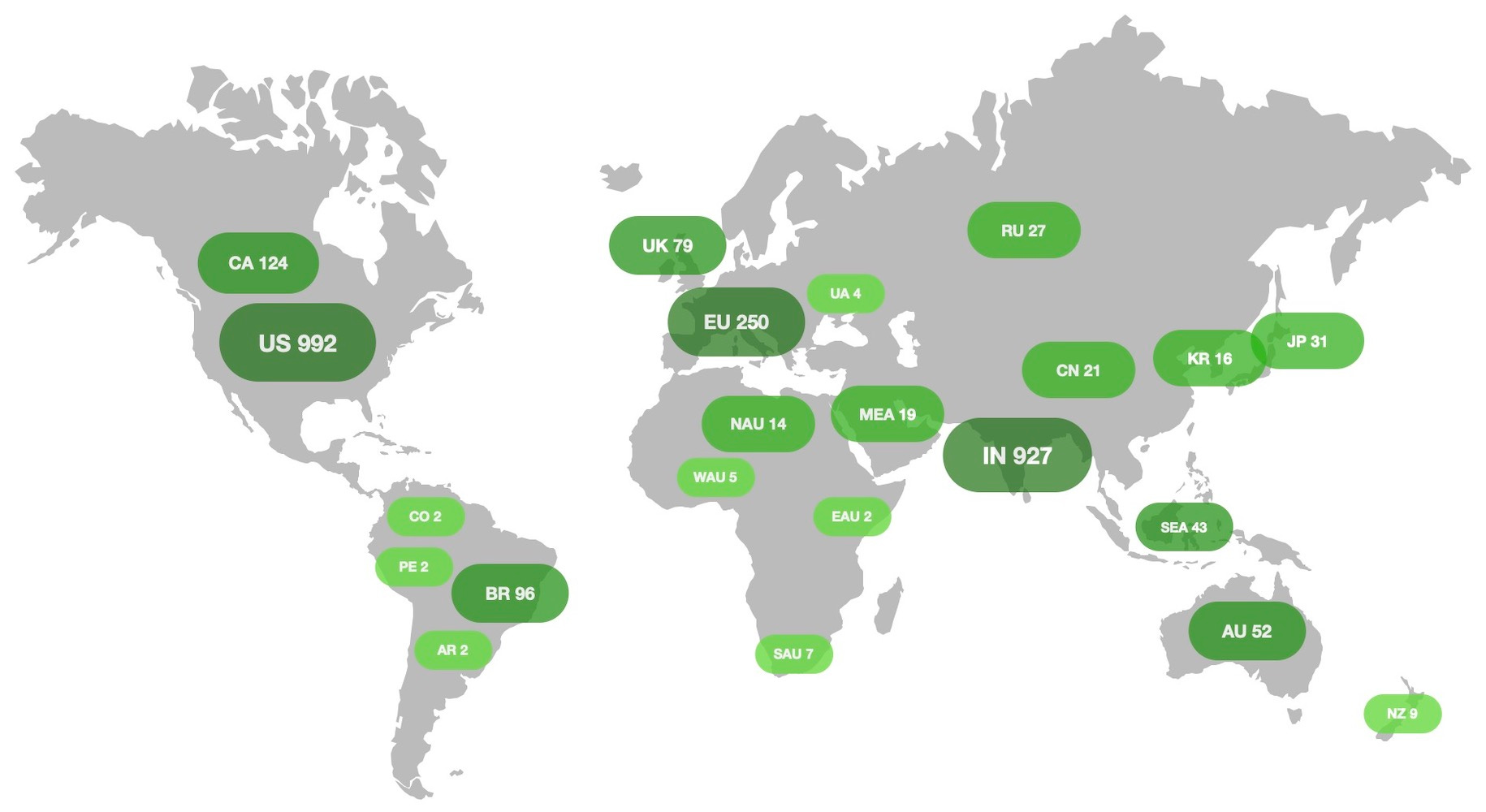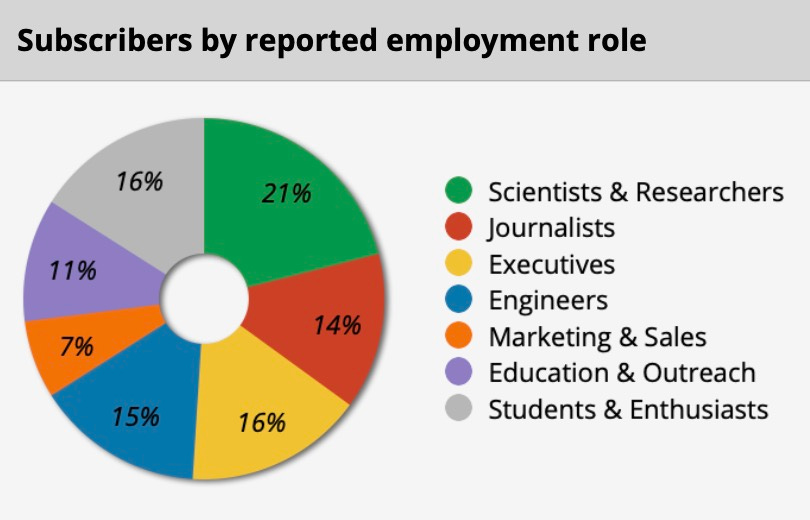Moon Monday #105: An Orion around Luna, CubeSat quests, ESA’s lunar ambitions, future mission updates, and more
NASA’s crew-capable Orion spacecraft now orbiting the Moon
In what seems to be a very successful Artemis I mission, NASA’s uncrewed Orion spacecraft entered its desired Distant Retrograde Orbit (DRO) around our Moon as of November 25. Upon completing about half an orbit on December 1 at an unconventionally high altitude of roughly 64,000 kilometers, Orion will propel itself to exit DRO and, on December 5, fly close to the Moon for a powered outward slingshot towards Earth.

Despite the fact that future Artemis astronauts flying to the Moon won’t be using this orbit, NASA chose DRO for Artemis I since it offers a highly stable, fuel-efficient trajectory to thoroughly test Orion’s systems, a critical element in the safety and success of all Artemis missions. To that end, NASA has been progressing through Orion’s many secondary objectives, including testing propellent sloshing in the tanks and how it’s affecting Orion’s trajectory and orientation, better calibrating star trackers for more precise navigation, testing navigation with an alternate thruster configuration for when the primary set somehow doesn’t work, and even working through some non-critical issues faced in the flight so far.
Relatedly, the fiery launch of the SLS rocket for the mission damaged parts of its mobile launch tower, including breaking the elevator and some pneumatic gas lines. It will take several months to complete all repairs. While some of the damage was greater than expected, NASA says most of these were accounted for in the planning and budget to launch the crewed Artemis II mission in 2024.
Statuses of secondary Artemis I payloads
Updates on the independent science & technology missions launched on Artemis I continue to be bittersweet.
- Japan’s EQUULEUS CubeSat successfully flew past the Moon on November 22 and is on the right trajectory to reach the Earth-Moon Lagrangian Point L2—where the Earth’s and Moon’s gravitational pulls roughly balance—in 18 months. EQUULEUS will study phenomena and changes in Earth’s plasmasphere due to the solar wind, the radiation particles and magnetic fields streaming from the Sun. It will also measure meteor impact flashes and the dust environment around the Moon, providing additional insights to best protect our future astronauts.
- Chris Gebhardt has an article on how Lockheed Martin, Amazon, and Cisco have been working through Orion’s Callisto system, which is a video-conferencing and voice assistant demonstration that could assist future Artemis astronauts.
- LunaH-Map’s propulsion system failed to put it in the desired lunar polar orbit. The team is now heating the system to get it to work properly. Considering that the CubeSat is supposed to map hydrogen—as an indicator of water ice—in permanently shadowed regions, in the variably lit south polar surface, and a meter below both in the highest resolution to date by flying just 12 kilometers above the lunar south pole, I really hope the mission stays on.
- Japan’s OMOTENASHI CubeSat continued to not be in communications with Earth, and the mission team thus couldn’t send it the necessary commands to execute a semi-soft lunar landing. The team is hoping that the CubeSat will get enough sunlight to power up in March 2023, which might provide an opportunity to establish contact. If that does happen, the team won’t attempt a lunar landing with the CubeSat anymore but instead try to carry out the mission’s secondary objectives, which includes measuring deep space radiation with its miniature active dosimeter to better inform us on how to protect future lunar astronauts.
Many thanks to Epsilon3 for sponsoring this week’s Moon Monday.
Thanks also to Kris Zacny of Honeybee Robotics and Michael Palank for supporting my independent writing.
A thank you to Louis Burtz as well, who wishes me to link to GiveWell instead. :)
ESA Moonlights its lunar ambitions
ESA’s Ministerial Council, a meeting of government ministers from each of the agency’s 22 Member States, has approved $17.5 billion for the next 3 years, a 17 percent funding increase compared to the 2019 budget, not counting inflation. Most notably, the council has approved ESA’s Moonlight plans to build a constellation of lunar satellites that will provide communications and navigation services to hardware on and around the Moon. The ambitious and versatile European Large Logistics Lander, primarily designed to supplement crewed missions post-2030 with cargo flights, is also green-lit for development.

The Council also continued support for ESA’s involvement in NASA’s Artemis campaign, which sees the agency provide the critical service module of NASA’s Orion spacecraft already and later this decade provide the NASA-led Gateway lunar orbital station’s i-HAB habitation module and the ESPRIT communications & refueling module. These ongoing and upcoming contributions has allowed Europe to bag at least three seats for their astronauts on Gateway.
The U.S. commits to using lunar resources, at scale
On November 17, the U.S. released its first “National Cislunar Science and Technology Strategy” to address how it intends to support sustainable exploration and use of our Moon, including the space around it. The document has a good summary of the major objectives so I’ll instead quote bits that stood out to me:
The U.S. government will support the development of orbital and Lunar surface technologies and other scalable capabilities that support an enduring human presence on planetary surfaces.
[…]
The United States government will support Lunar resource assessments, as well as the advancement of research, development, and demonstration of capabilities for using materials sourced from the Moon and other celestial bodies. Such capabilities include resource characterization and surveys, manufacturing of components from in-situ materials, autonomous assembly of structures, construction of structures that maximize the use of in-situ materials, and processing of useful molecules such as water and oxygen.
[…]
U.S. government organizations will leverage collaborations with private entities to enable capabilities for large-scale ISRU and advanced manufacturing at the Moon, consistent with the U.S. National Strategy for In-space Servicing, Assembly, and Manufacturing.
[…]
[The U.S. government will] support social science research related to crewed exploration and permanent inhabitation of deep space to support enduring human presence in space.
More Moon
- ispace Japan is now targeting November 30 for launching its first Moon landing mission on a SpaceX Falcon 9 rocket. The lander will be on a low-energy trajectory to the Moon, after four months of which it will enter lunar orbit and subsequently target landing in April 2023. The launch can be viewed on ispace’s YouTube channel. Here’s a great picture of the lander inside Falcon 9’s fairing.
- SpaceX’s 26th commercial cargo mission for NASA, which launched to the International Space Station on November 26, carried a Moon Microscope. It’s an integrated kit for blood sample staining and its microscopic imaging to accelerate assessing of astronaut health and food & water quality by remote experts on Earth, as preparation for future Moon missions.
- China’s space agency revealed last week that their robotic Chang’e 6 mission, aiming to return at least 2 kilograms of lunar farside samples in 2025, will carry three European scientific instruments on the lander. The Chang’e 6 orbiter will carry a Pakistani CubeSat called “ICUBE-Q”, which would be the country’s first Moon mission.
Space blogs I recommend
Now seems to be a great time for forging and enhancing direct connections between readers and creators, that is, without any social platforms or algorithms in between. I recommend following these indie, independent blogs and/or newsletters.
- The Orbital Index: I’ve been saying this before Andrew & Ben started sponsoring Moon Monday, and it stands: The Orbital Index is my favorite curated, technical space newsletter. In fact, it was my part inspiration for starting Moon Monday.
- Pradeep's Space Newsletter, a sporadic newsletter providing a good, neutral-toned overview of India’s space technology progress.
- Space and planetary science articles by Alexandra Witze: She brings out a great diversity of viewpoints and highlights some key ongoing and upcoming challenges in space exploration.
- Planetocracy by Peter Hague: He frequently has uniquely thought provoking, large-picture takes on some notable happenings and trends in space exploration.
This is obviously far from an exhaustive list, even among writings I really love, and so maybe I will keep recommending curated space resources every now and then. 🚀
A Moon Monday update
One of my goals when starting Moon Monday was to reach a truly global audience, including people at space agencies, companies, research institutions, and publications. Here’s the relative distribution of my 3500+ readers by country, work roles, and (common) employment organizations. I’m proud of this. 🙂



If your organization would like to sponsor Moon Monday while increasing your visibility among this unique newsletter’s highly enthusiastic audience, get in touch.
→ Browse the Blog | About
